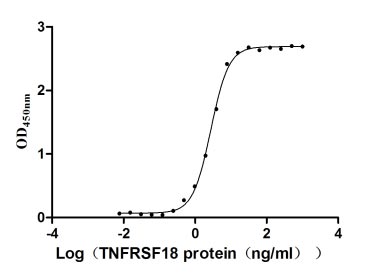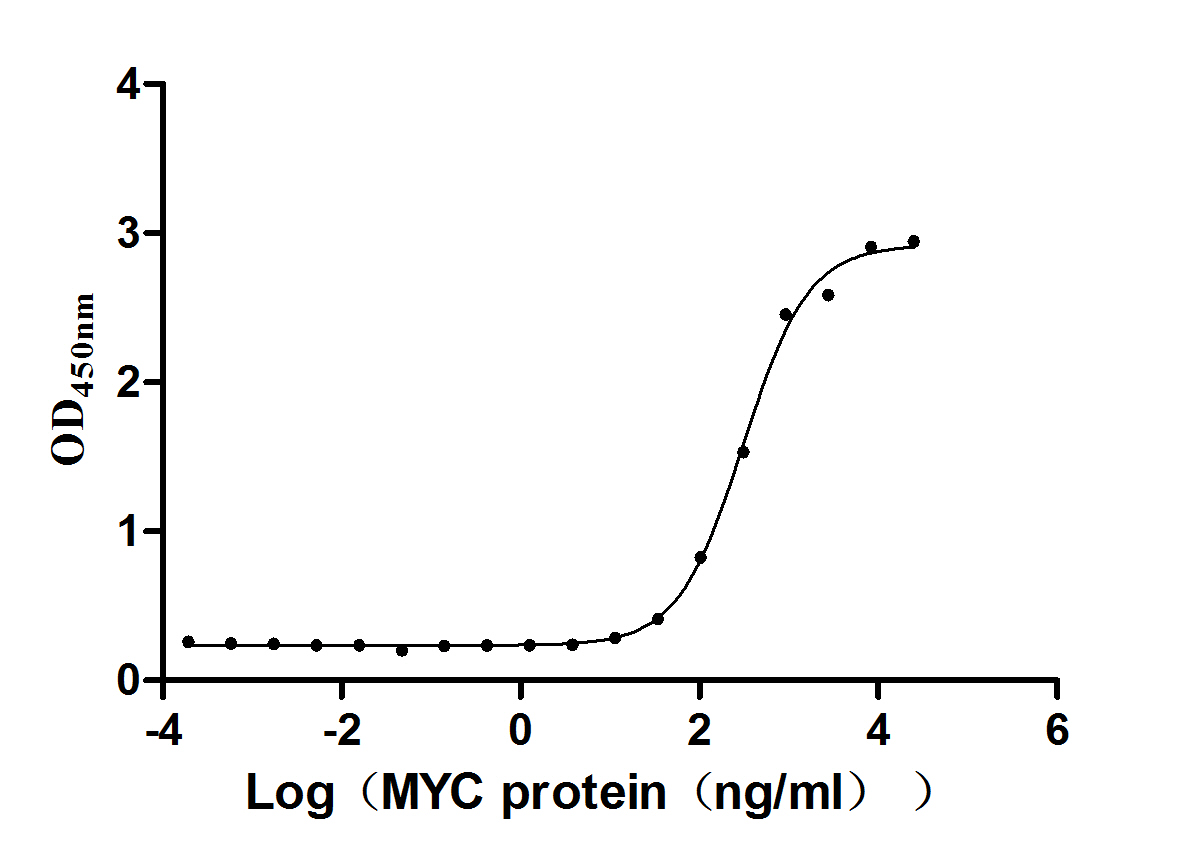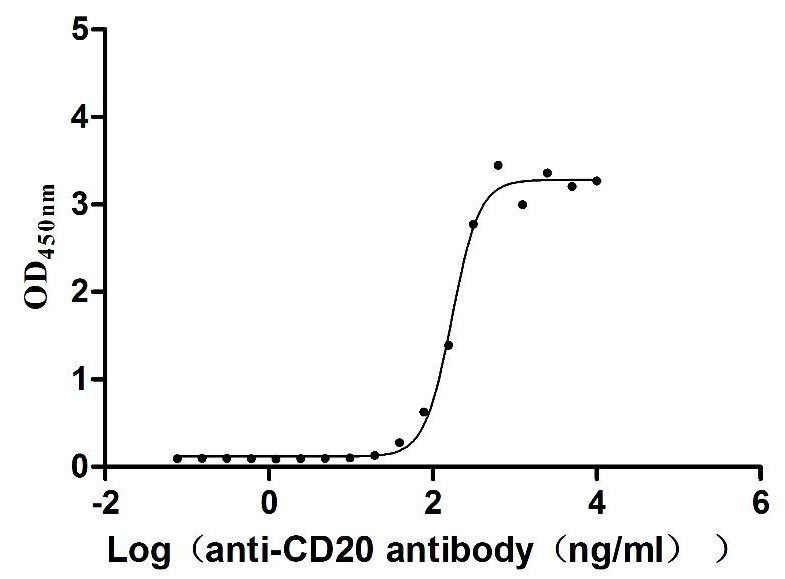Recombinant Mouse Melanin-concentrating hormone receptor 1 (Mchr1), partial
-
货号:CSB-YP013584MO1
-
规格:
-
来源:Yeast
-
其他:
-
货号:CSB-EP013584MO1
-
规格:
-
来源:E.coli
-
其他:
-
货号:CSB-EP013584MO1-B
-
规格:
-
来源:E.coli
-
共轭:Avi-tag Biotinylated
E. coli biotin ligase (BirA) is highly specific in covalently attaching biotin to the 15 amino acid AviTag peptide. This recombinant protein was biotinylated in vivo by AviTag-BirA technology, which method is BriA catalyzes amide linkage between the biotin and the specific lysine of the AviTag.
-
其他:
-
货号:CSB-BP013584MO1
-
规格:
-
来源:Baculovirus
-
其他:
-
货号:CSB-MP013584MO1
-
规格:
-
来源:Mammalian cell
-
其他:
产品详情
-
纯度:>85% (SDS-PAGE)
-
基因名:
-
Uniprot No.:
-
别名:Mchr1; Gpr24; Slc1; Melanin-concentrating hormone receptor 1; MCH receptor 1; MCH-R1; MCHR-1; G-protein coupled receptor 24; MCH-1R; MCH1R; MCHR; SLC-1; Somatostatin receptor-like protein
-
种属:Mus musculus (Mouse)
-
蛋白长度:Partial
-
蛋白标签:Tag type will be determined during the manufacturing process.
The tag type will be determined during production process. If you have specified tag type, please tell us and we will develop the specified tag preferentially. -
产品提供形式:Lyophilized powder
Note: We will preferentially ship the format that we have in stock, however, if you have any special requirement for the format, please remark your requirement when placing the order, we will prepare according to your demand. -
复溶:We recommend that this vial be briefly centrifuged prior to opening to bring the contents to the bottom. Please reconstitute protein in deionized sterile water to a concentration of 0.1-1.0 mg/mL.We recommend to add 5-50% of glycerol (final concentration) and aliquot for long-term storage at -20℃/-80℃. Our default final concentration of glycerol is 50%. Customers could use it as reference.
-
储存条件:Store at -20°C/-80°C upon receipt, aliquoting is necessary for mutiple use. Avoid repeated freeze-thaw cycles.
-
保质期:The shelf life is related to many factors, storage state, buffer ingredients, storage temperature and the stability of the protein itself.
Generally, the shelf life of liquid form is 6 months at -20°C/-80°C. The shelf life of lyophilized form is 12 months at -20°C/-80°C. -
货期:Delivery time may differ from different purchasing way or location, please kindly consult your local distributors for specific delivery time.Note: All of our proteins are default shipped with normal blue ice packs, if you request to ship with dry ice, please communicate with us in advance and extra fees will be charged.
-
注意事项:Repeated freezing and thawing is not recommended. Store working aliquots at 4°C for up to one week.
-
Datasheet :Please contact us to get it.
相关产品
靶点详情
-
功能:Receptor for melanin-concentrating hormone, coupled to both G proteins that inhibit adenylyl cyclase and G proteins that activate phosphoinositide hydrolysis.
-
基因功能参考文献:
- This study demonstrated that the Neurochemical Heterogeneity Among Lateral Hypothalamic Melanin-Concentrating Hormone Neurons. PMID: 28966976
- following pups retrieval, MCHR1 knockout mice display a lower level of Fos expression than wild type mice in the ventral tegmental area, and nucleus accumbens PMID: 27617778
- This study showed that KO of mchr1 mice had significantly higher levels of both punished and non-punished food maintained responding. PMID: 27633558
- MCH1-Rs regulate the rewarding properties of alcohol through interactions with signaling cascades in the nucleus accumbens shell. PMID: 27044354
- This study supports the use of the Mchr1-cre mouse for outlining the neuroanatomical distribution and neurochemical phenotype of MCHR1 neurons. PMID: 23605441
- This study demonistrated that lack of MCH receptor provoked a ventricular size increase and beat frequency of ependymal cilia. PMID: 23708141
- Mchr1 and Sstr3 are expressed and colocalized within cilia in multiple mouse brain regions, and they form heteromers. PMID: 23029470
- Disruption of the melanin-concentrating hormone receptor 1 (MCH1R) affects thyroid function PMID: 23024261
- The elevated basal body temperature and reduction in NREM sleep time resulting from shorter NREM episode durations observed in knockout mice suggests that central MCH(1) receptor has a role in thermoregulation and presumably stabilization of NREM sleep. PMID: 21074567
- Data show that the melanin-concentrating hormone/MCH1R system is one of the players mediating behavioral and metabolic responses upon increased caloric consumption. PMID: 20411353
- In melanin-concentrating hormone receptor 1 knock-out mice, long-term synaptic depression was strongly diminished in hippocampus. PMID: 20592115
- The data indicate that the MCH system is involved in the regulation of PTZ and pilocarpine seizure threshold. PMID: 20709149
- The gene encoding the mouse melanin-concentrating hormone receptor 1 was isolated and its structural organization and flanking regions were characterized. PMID: 15093132
- metoprolol completely reversed the tachycardia seen in MCHR1(-/-) mice, suggesting an increased sympathetic tone PMID: 15130877
- Periplakin interferes with G protein activation by the melanin-concentrating hormone receptor-1 by binding to the proximal segment of the receptor C-terminal tail PMID: 15590649
- In summary, the MCHr is not required for ghrelin induced feeding. PMID: 15607734
- Deletion of MCH1r results in an upregulation of mesolimbic dopamine receptors and norepinephrine transporter, indicating that MCH1r may negatively modulate mesolimbic monoamine function. PMID: 15673672
- Castration and testosterone treatment on the vasculature in the ventral prostate in adult rats and mice alter expression of this protein. PMID: 15845622
- Triple-substitution mutants of intracellular loops 1 and 3 can activate calcium mobilization, albeit with lower efficacy or potency. PMID: 15890773
- Pyramidal neurons in knockout mice revealed significantly decreased NMDA responses. PMID: 15926931
- These data support the notion that MIZIP might interact with elanin-concentrating hormone receptor 1 (MCHR1) in a cell type specific manner in vivo, suggesting a role in the regulation of MCH signalling in distinct regions of the mammalian brain. PMID: 15950311
- show that MCHR1 can modulate stress- and anxiety-like behaviors and suggest that this may be due to changes in serotonergic transmission in forebrain regions PMID: 15988472
- MCHR1 may contribute to the neurobiological mechanisms of conditioned cocaine-induced psychomotor effects, possibly to those underpinning sensitization, and to a lesser extent to those sub-serving acute pharmacological cocaine action. PMID: 16839618
- the main phenotype displayed by Mchr1 knockout mice was hyperactivity, reduced anxiety, and faster visomotor responses in the absence of nay discernable deficit of sensorimotor and spacial learning abilities PMID: 17270288
- MCH1 receptor signalling is involved in the development of fatty liver, as well as obesity, in ovariectomized mice PMID: 17519948
- male MCH-1R knockout mice consume more alcohol than wild-type and heterogenous mice PMID: 17550369
- Our results do not support the hypothesis of a functional contribution of MCHR1 receptors to the addictive effects of D-amphetamine PMID: 17996928
- MCH(1) receptor KO mice are hypersensitive to the behavioral and molecular effects of the dopaminergic psychostimulant d-amphetamine and Increased frontal cortical MAPK phosphorylation and c-fos expression. PMID: 18000809
- These results demonstrate that MCH, in addition to its known role in feeding and weight regulation, plays a critical role in regulating Acb dopamine signaling and related behavioral responses. PMID: 18281019
- Animals with genetically inactivated melanin-concentrating hormone receptor 1 signaling exhibit altered vigilance state architecture and sleep homeostasis. PMID: 18380672
显示更多
收起更多
-
亚细胞定位:Cell membrane; Multi-pass membrane protein.
-
蛋白家族:G-protein coupled receptor 1 family
-
组织特异性:Expressed predominantly in the brain. Expression in brain is negatively regulated by leptin. Also found in the epithelium of the tongue and kidney.
-
数据库链接:
KEGG: mmu:207911
STRING: 10090.ENSMUSP00000126191
UniGene: Mm.323523
Most popular with customers
-
Recombinant Human Tumor necrosis factor receptor superfamily member 18 (TNFRSF18), partial (Active)
Express system: Mammalian cell
Species: Homo sapiens (Human)
-
Recombinant Human papillomavirus type 16 Protein E7 (E7) (Active)
Express system: E.coli
Species: Human papillomavirus type 16
-
Recombinant Rabbit Tissue factor pathway inhibitor (TFPI) (Active)
Express system: Mammalian cell
Species: Oryctolagus cuniculus (Rabbit)
-
Recombinant Human Epithelial discoidin domain-containing receptor 1 (DDR1), partial (Active)
Express system: Mammalian cell
Species: Homo sapiens (Human)
-
Recombinant Dog B-lymphocyte antigen CD20 (MS4A1)-VLPs (Active)
Express system: Mammalian cell
Species: Canis lupus familiaris (Dog) (Canis familiaris)
-
Recombinant Mouse Complement component C1q receptor (Cd93), partial (Active)
Express system: Mammalian cell
Species: Mus musculus (Mouse)
-
Recombinant Macaca fascicularis CUB domain containing protein 1 (CDCP1), partial (Active)
Express system: Mammalian cell
Species: Macaca fascicularis (Crab-eating macaque) (Cynomolgus monkey)
-
Recombinant Human Myosin regulatory light chain 12A (MYL12A) (Active)
Express system: E.coli
Species: Homo sapiens (Human)




















